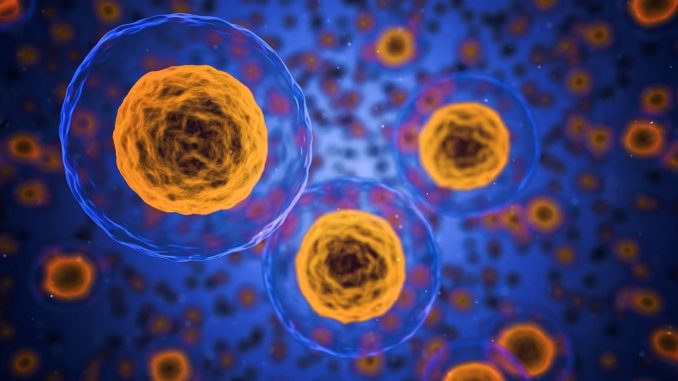
A perfusion cell culture process is a specialized technique used in biotechnology and biopharmaceutical industries for the continuous cultivation of cells. In contrast to traditional batch or fed-batch cell culture processes, where cells are grown in a fixed volume of media and harvested at the end of the run, perfusion cell culture involves a continuous supply of fresh media while removing the spent media and product in real-time.
In a perfusion cell culture process, cells are kept in a bioreactor or cell culture vessel, and fresh media is continuously added at a controlled rate while an equal amount of spent media is removed simultaneously. This creates a continuous flow of nutrients to the cells and allows for the removal of waste products and secreted proteins or biopharmaceuticals without disturbing the cell population. The volume in the reactor is carefully controlled and synchronised with the feed pump.
To all intents and purposes, the perfusion bioreactor looks like a standard bioreactor system with a vessel and agitator. Operation is similar to a CSTR.
The main element is the treatment of the media with cells. The removed liquid is filtered. The filtrate (permeate) containing the waste material is removed whilst the cells are retained and collected. In many cases the cells are returned to the fermenter for further cultivation.
We mention some of the more advanced systems later on in this piece.
Key features and benefits of perfusion cell culture
Continuous Nutrient Supply
The continuous supply of fresh media ensures that the cells always have access to essential nutrients, maintaining a more stable and optimal environment for cell growth and productivity.
Continuous Product Harvesting
As the product is continuously removed from the bioreactor, it prevents the accumulation of high concentrations of the desired protein or biopharmaceutical, reducing the risk of product degradation or inhibition.
Higher Cell Density
Perfusion cell culture allows for higher cell densities compared to batch or fed-batch processes. This increased cell density can result in higher overall productivity.
Long-term Cultivation
Perfusion systems can be run for extended periods, enabling long-term cell culture processes, which may be necessary for the production of certain complex biopharmaceuticals.
Reduced Volumes and Footprint
Since perfusion processes don’t require large volumes of media in the bioreactor, they can lead to reduced media consumption and a smaller bioreactor footprint.
Optimising Perfusion Cell Reactors
Recent interest has focused on how to optimise this type of bioreactor. Conventionally, small-scale devices and equipment is used to establish cell fermentation especially the high cell densities that make this technology so attractive. Studies can even be conducted in microwell plates using just mL quantities which cuts down on space and resources needed for optimization studies. There are good examples of this type of application in the scientific media (Tregido et al., 2023).
One of the major benefits of any perfusion culture system compared to fed-batch etc. is the reduction in the perfusion rate. This is ideally reduces a rate below 1 vessel volume per day (VVD). It means that a high titre of cells can be obtained with mimimal liquid throughput. From the cost perspective, this benefit means that the operating costs are significantly curtailed and makes it an attractive proposition for small biotech. companies to explore cell systems that had not been previously available to them (Gomez et al., 2017).
For the perfusion rate to be reduced as much as possible, the media is prepared in such a way that there is no loss in nutritional value and more importantly the osmolality is kept low enough to avoid damaging the cells. The cell lines are chosen so that the perfusion rate can be reduced as much as possible without losing their ability to grow well.
Process Control
Perfusion cell culture processes often incorporate sophisticated control strategies, including feedback loops and continuous monitoring of critical process parameters. This enhances process robustness and performance.
Perfusion cell culture is commonly used in the production of biopharmaceuticals, such as monoclonal antibodies, therapeutic proteins, vaccines, and other complex biologics. These products often require specific post-translational modifications or have unique folding patterns that can be better achieved in a continuous culture system.
A typical perfusion cultivation can be performed in any sized perfusion bioreactor. Many fermentations use perfusion bags e.g. Flexsafe® {Sartorius, Germany} contained in a bioreactor housing which has a rocking motion. The bioreactor bag is inoculated with a small number of cells. Process conditions are maintained. The pH for example will be controlled using carbon dioxide gas. When a particular cell density is reached, perfusion begins around a rate of one vessel volume exchange of medium every day. The perfusion rate can be adjusted usually through step-wise increases to reflect the steadily increasing cell density. There is also the possibility of continuous adjustment based on in-line biomass measures so that a constant cell-specific perfusion rate (CSPR) is obtained.
However, perfusion cell culture is more complex and requires advanced process monitoring and control systems. It is typically implemented in large-scale bioreactors and is often used in combination with other cell culture strategies like fed-batch processes to optimize productivity and achieve the desired product quality.
References
Gomez, N., Ambhaikar, M., Zhang, L., Huang, C. J., Barkhordarian, H., Lull, J., & Gutierrez, C. (2017). Analysis of Tubespins as a suitable scale‐down model of bioreactors for high cell density CHO cell culture. Biotechnology Progress, 33(2), pp. 490-499 (Article).
Tregidgo, M., Lucas, C., Dorn, M., & Micheletti, M. (2023). Development of mL-scale pseudo-perfusion methodologies for high-throughput early phase development studies. Biochemical Engineering Journal, 195, 108906 (Article)
Great biotech. Article.